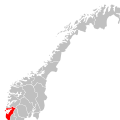Haugesund
| Haugesund kommune | |||
|---|---|---|---|
| — Municipality — | |||
 |
|||
|
|||
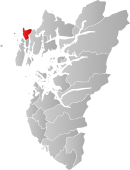 |
|||
| Coordinates: | |||
| Country | Norway | ||
| County | Rogaland | ||
| District | Haugaland | ||
| Administrative centre | Haugesund | ||
| Government | |||
| - Mayor (2006) | Petter Steen jr. (H) | ||
| Area | |||
| - Total | 73 km2 (28.2 sq mi) | ||
| - Land | 68 km2 (26.3 sq mi) | ||
| Area rank | 403 in Norway | ||
| Population (2004) | |||
| - Total | 33 665 | ||
| - Rank | 24 in Norway | ||
| - Density | 489/km2 (1,266.5/sq mi) | ||
| - Change (10 years) | 9.4 % | ||
| Demonym | haugesundar/-er araber[1] |
||
| Time zone | CET (UTC+1) | ||
| - Summer (DST) | CEST (UTC+2) | ||
| ISO 3166 code | NO-1106 | ||
| Official language form | Bokmål | ||
| Website | haugesund.kommune.no | ||
|
|
|||
Haugesund is a town and municipality in the county of Rogaland, Norway.
Contents |
Location
Haugesund was separated from Torvastad as a town and municipality of its own in 1855. The rural municipality of Skåre was merged with Haugesund on January 1, 1958.[2] Haugesund is a small municipality, only 73 km². The population is 33,022, giving the municipality a population density of 459 people per km².
The town is situated on a strategically important sound through which ships could pass without traversing heavy seas. In the early years the coastal waters off Haugesund were a huge source of herring, and the town grew accordingly. Despite being barely a village back then, King Harald Fairhair lived at Avaldsnes, very close to the modern town of Haugesund. In the last decades, the town, like its neighbours, has been turning towards the petroleum industry, the herring being long gone.
Haugesund is the main cultural centre for its region, and is home to several festivals, the largest being the Norwegian International Film Festival and Sildajazz, an international jazz festival with approximately 70 bands and close to 200 concerts.
As of 2009, Haugesund's urban agglomeration has a population of approximately 100,000, of which 48,987 live in Haugesund and 38,000 live on Karmøy.[3] The Haugesund Region, a statistical metropolitan area, consisting of the municipalities Karmøy, Haugesund, Tysvær, Sveio and Bokn, has a population of approx. 100,000 as of 2009.
History
Haugesund was founded in 1855 when it was divided from Torvastad, a former neighbouring municipality, consequently celebrating its 150-year anniversary in 2004. At the time of division, Haugesund had a population of 1,066.[2] The town is named after the strait Haugesundet. The first element is the genitive case of Hauge from the Old Norse word haugr meaning hill or mound. The last element is sund meaning strait or sound.
In the early years, the coastal waters of Haugesund were a huge source of herring, and the town grew accordingly. Despite being a fairly young town, the areas around Haugesund were lands of power during the Viking Age. Harald Fairhair, the first king of Norway, had his home at Avaldsnes, very close to the city. Fairhair was buried at Haraldshaugen, a burial mound adjacent to Karmsund. This site is the namesake of the town and municipality of Haugesund. The national monument at Haraldshaugen was raised in 1872, to commemorate the 1000th anniversary of the Battle of Hafrsfjord in 872. The Battle of Hafrsfjord has traditionally been regarded as when western Norway was unified under a single monarch for the first time.[4]
The protective sounds of Smedasund and Karmsund gave the town potential to grow in both fishing and shipping. Even to this day, Karmsund is one of Norway's busiest waterways. The town is still growing geographically even though the population has increased only moderately the last decade. Today the herring is long gone, and the town is turning more and more towards the petroleum industry, like its neighbour Stavanger.
The coat-of-arms is from 1929,[5] and shows three seagulls. It replaced the old coat-of-arms which showed a herring barrel, an anchor, and three seagulls. The current coat-of-arms was drawn by Hallvard Trætteberg.[5]
Geography
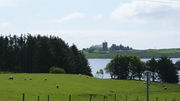
Haugesund has a coastline with the North Sea, however, the island of Karmøy and the archipelago Røvær shelter most of the city from the rough waters of the ocean. The sound of Karmsund, located between Karmøy and Haugesund used to be very strategically important, since ships could pass without having to sail through heavy sea. Haugesund's city centre has a distinctive street layout, similar to those found in Kristiansand and Oslo. Haugesund has a typical maritime climate with mild winters, cool but pleasant springs, and mild summers lasting until the end of September. Monthly 24-hr average range from 1.1 °C in February to 14 °C in August. Mean annual precipitation is 1520 mm, with September - December as the wettest period.[6]
The population is 48,987, and with an area of only 73 km², this gives a population density of 489 people per km². As of 2007, Haugesund's agglomeration has a population of 44,183, of which 34,140 live in Haugesund and 10,043 live in Karmøy.[3] The Haugesund Region, a statistical metropolitan area, consisting of the municipalities Karmøy, Haugesund, Tysvær, Sveio and Bokn, has a population of approximately 100.000 as of 2009.
The municipality includes several islands. Risøy and Hasseløy are densely built, and connected to the mainland by bridges. Røvær which lies further out and consists of a number of islands, is also populated and connected to the mainland by ferry. Vibrandsøy and its neighboring islands is now mainly a recreational area.
Cityscape
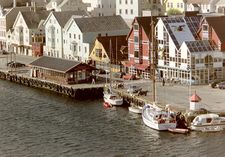
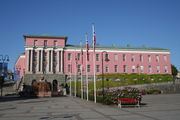
Haugesund's town hall was built in 1931, celebrating its 75th anniversary in 2006.[7] The pink city hall, designed by Gudolf Blakstad and Herman Munthe-Kaas,[8] is one of the finest neo-classical buildings in Norway, and has been elected the most beautiful building in Haugesund.[9] It is also included in the new Norwegian edition of monopoly after it was successful in a national vote. The building may not be altered in any way without permission from the national preservation agency. It overlooks the town square and a park which was inaugurated on 28 August 1949.[9]
The town has during the last 20 years established its position as the main trading centre for Haugaland and southern parts of Hordaland. It has several relatively large shopping centres, considering the size of the town. However, this has led to a decline of the trade and shopping activity in the town centre.

Transport
Haugesund Airport, located on the island of Karmøy to the southwest of Haugesund, is connected to Oslo (operated by Scandinavian Airlines System, 7 flights a day), Bergen, London (operated by Ryanair, three flights a week), Edinburgh twice a week (operated by Ryanair during the summer), Bremen (operated by Ryanair during the summer). The Norwegian airline Coast Air was based at Haugesund airport, but filed for bankruptcy on 23 January 2008.[10]
Haugesund is connected to Stavanger and Bergen by catamaran and bus services, and to Oslo by bus. Local bus transport is provided by Kolumbus. The town is connected to Utsira, Røvær, Feøy and Randaberg by ferry. The road connection to Stavanger is interrupted by one ferry from Arsvågen to Mortavika, while taking the ferry from Sandvikvåg in Fitjar to Halhjem in Os is needed if going to Bergen by road.
Culture

Haugesund has strong historical bonds to the sea and especially the herring. In the second weekend of August each year, the herring is celebrated at the jazz-festival Sildajazz (Sild is Norwegian for herring). Local, as well as national and international jazz musicians, are presented at Sildajazz.
Every year in June there is also held a rock festival in Haugesund called "Rockfest", with international as well as national and local bands. The festival was held for the first time in 2004, then as a part of the celebration of the town's 150 year anniversary.
The Norwegian International Film Festival has since 1973 been held in Haugesund each year, showing films for the cinema representing a wide geographical and cultural selection. The Amanda Award, Norway's most honoured film award, has been held in Haugesund since 1985 in concurrence with the film festival.
Haugesunds Avis is a daily newspaper published in Haugesund, but with branches in Bømlo, Kopervik, Odda, Sauda and Stord. Founded in 1895, it is today owned by the investment group Mecom Group, and is as such part of the media group Edda Media. In 2006, Haugesunds Avis had a circulation of 33 448.[11] As of 2007, the executive editor is Tonny Nundal. The newspaper owns the local radio channel Radio 102.
Education
The main campus of Stord/Haugesund University College is located in Haugesund. Established as recently as 1994, it is the result of the merger between Haugesund Nursing College, Stord Teachers College and Stord Nursing College.[12] The university college has approximately 2700 students and 260 employees,[12] thus making it one of the smallest university colleges in Norway.
International relations
Twin towns — sister cities
Haugesund is twinned with:
Each of the sister cities have given name to a street in Haugesund. The streets are located in the same area in the city centre.
References
- ↑ "Personnemningar til stadnamn i Noreg" (in Norwegian). Språkrådet. http://www.sprakrad.no/Sprakhjelp/Rettskriving_Ordboeker/Innbyggjarnamn.
- ↑ 2.0 2.1 Dag Jukvam / Statistics Norway (1999). Historisk oversikt over endringer i kommune- og fylkesinndelingen. http://www.ssb.no/emner/00/90/rapp_9913/rapp_9913.pdfl. (Norwegian)
- ↑ 3.0 3.1 "Urban settlements. Population and area, by municipality. 1 January 2007" (in Norwegian). Statistics Norway. 2007. http://www.ssb.no/english/subjects/02/01/10/beftett_en/tab-2007-06-07-01-en.html. Retrieved 2007-10-24.
- ↑ Haraldshaugen monument to the founder of Norway in Haugesund (Stavanger Travel AS)
- ↑ 5.0 5.1 "Haugesund byvåpen" (in Norwegian). Haugesund kommune. http://www.haugesund.kommune.no/cgi-bin/haugesund/imaker?id=46065. Retrieved 2007-10-24.
- ↑ met.no: Normaler for
Haugesund - ↑ Idar H. Pedersen (2006). "Haugesund Rådhus" (in Norwegian). Haugesund kommune. http://www.haugesund.kommune.no/cgi-bin/haugesund/imaker?id=46943&visdybde=2&aktiv=46943. Retrieved 2007-10-24.
- ↑ Idar H. Pedersen (2007). "Den italienske drømmen" (in Norwegian). http://www.haugesund.kommune.no/cgi-bin/haugesund/imaker?id=52062. Retrieved 2007-10-24.
- ↑ 9.0 9.1 "The City Hall in Haugesund" (in Norwegian) (PDF). Haugesund kommune. http://www.haugesund.no/data/f/0/48/38/8_2401_0/Brosjyre_hgsd.pdf. Retrieved 2007-10-24.
- ↑ http://www.aftenposten.no/english/business/article2213723.ece
- ↑ "Avisenes leser- og opplagstall for 2006" (in Norwegian). Mediebedriftenes Landsforening. 2007. http://mediebedriftene.no/index.asp?id=71672. Retrieved oktober 26 2007.
- ↑ 12.0 12.1 "Om HSH" (in Norwegian). Høgskolen Stord/Haugesund. 2007. http://www.hsh.no/om_hsh.htm. Retrieved 2007-10-24.
- ↑ 13.0 13.1 13.2 Idar H. Pedersen (2004). "Vennskapsbyer" (in Norwegian). Haugesund kommune. http://www.haugesund.kommune.no/cgi-bin/haugesund/imaker?id=12128&visdybde=2&aktiv=12128. Retrieved 2007-10-25.
External links
- Tourist information (English, German and Norwegian language)
- Municipality website (Norwegian language)
- Haugalandet.net
- Haraldshaugen, the national monument
|
|||||||
|
||||||||||||||||||||||||||||||||||||||||||||||||||||||||||||||||||||||||||||||||||||||||||||||||||||||||||||

